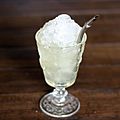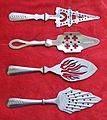Absinthe facts for kids

Reservoir glass with naturally coloured verte absinthe and an absinthe spoon
|
|
| Type | Spirit |
|---|---|
| Country of origin | Switzerland |
| Alcohol by volume | 45–74% |
| Proof (US) | 90–148 |
| Colour | Green |
| Flavour | Anise |
Absinthe is a special kind of strong drink made by distilling (a process like boiling and cooling to separate liquids) different herbs. It tastes like anise (a flavor similar to licorice) and is made from plants like grand wormwood, green anise, and sweet fennel.
Absinthe usually has a natural green color, but it can also be clear. In old stories, it was often called "the green fairy." Sometimes people mistakenly call it a liqueur, but it doesn't usually have sugar added when it's bottled. This means it's classified as a spirit. Even though it's bottled as a strong drink, people usually mix it with water before they drink it.
Absinthe first came from the Neuchâtel area in Switzerland in the late 1700s. It became very popular in France in the late 1800s and early 1900s. Many famous artists and writers in Paris, like Vincent van Gogh, enjoyed absinthe.
Absinthe started to become popular again in the 1990s. By the early 2000s, almost 200 different types of absinthe were being made in many countries. These included France, Switzerland, Austria, Germany, the Netherlands, Spain, and the Czech Republic.
What is Absinthe Made Of?
The three main herbs used to make absinthe are green anise, florence fennel, and grande wormwood. These three are often called the 'holy trinity'.
Many other herbs can also be used to give absinthe its unique flavor. Some of these include hyssop, melissa, star anise, petite wormwood, angelica root, sweet flag, dittany leaves, coriander, veronica, juniper, nutmeg, and various mountain herbs.
Images for kids
-
Édouard Manet, The Absinthe Drinker, c.1859
-
Pablo Picasso, 1901–02, Femme au café (Absinthe Drinker), oil on canvas, 73 cm × 54 cm (29 in × 21 in), Hermitage Museum, Saint Petersburg, Russia
-
The Drinkers by Jean Béraud (1908)
See also
 In Spanish: Absenta para niños
In Spanish: Absenta para niños















